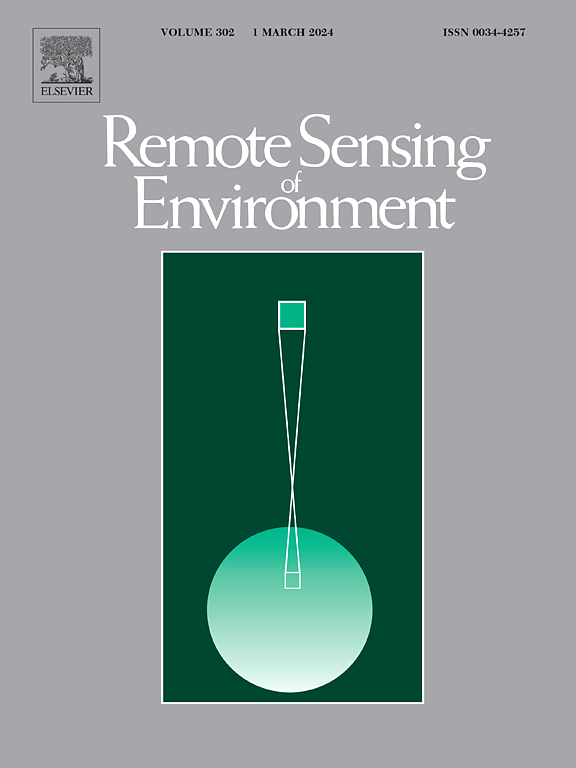Monitoring Spartina Alterniflora removal dynamics across coastal China using time series Sentinel-1 imagery
IF 11.1
1区 地球科学
Q1 ENVIRONMENTAL SCIENCES
引用次数: 0
Abstract
Invasions by Spartina species have posed serious threats to coastal ecosystems worldwide. Since the introduction of Spartina alterniflora (S. alterniflora) in China in 1979, it has expanded across 68,000 ha of coastal wetlands by 2020. In 2022, the Chinese government issued the “Special Action Plan for the Prevention and Control of Spartina alterniflora (2022–2025)”, aiming for nationwide eradication by 2025. As local and provincial removal efforts progress, timely information on removal status and timing is crucial for tracking the project's progress, assessing the effectiveness of control measures, and facilitating in-depth research on S. alterniflora re-establishment mechanism. Frequent cloud cover hinders the application of optical satellite imagery in timely monitoring of S. alterniflora removal in coastal areas. The all-weather Sentinel-1 SAR sensor overcomes this limitation, offering frequent acquisitions suitable for accurate mapping of S. alterniflora removal. In this study, we present the SAR Time Series Change and change Time Detection (STS-CTD) model, a deep learning framework designed to detect S. alterniflora removal events using Sentinel-1 time series imagery, providing information on where and when S. alterniflora was removed. The model integrates Transformer encoder, multi-kernel Conv1D decoder, and Band Dropout training strategy to learn the abrupt changes in time series backscatters and radar indices caused by plant removal. We applied the model within the boundaries of national-scale S. alterniflora map and generated the first S. alterniflora removal maps across China's coastline during 2021 to 2023. Our key findings include: (1) The resultant S. alterniflora removal map achieved an overall accuracy (OA) of 97.95 % and an F1-score of 98.39 % for removal identification, and the removal timing estimation exhibited a Mean Absolute Error (MAE) of 6.77 days and a Root Mean Square Error (RMSE) of 14.68 days; (2) the multi-kernel Conv1D and Band Dropout strategy considerably improved the model performance compared to models using only Transformer encoder and conventional Dropout; (3) the STS-CTD model outperformed state-of-the-art time series analysis models, including Bi-LSTM, Bi-GRU, TCN, and InceptionTime; (4) the model demonstrated strong temporal transferability, showing promise for application in future years; (5) it effectively mitigated noise from SAR imaging and tidal inundation, though continuous inundation and incomplete removal reduced accuracy in certain areas. The STS-CTD model and the resulting national-scale maps offer an operational solution for assessing invasive species management in coastal wetlands.
利用Sentinel-1时间序列影像监测中国沿海互花米草清除动态
米草属植物的入侵对全球沿海生态系统构成了严重威胁。自1979年引进互花米草(S. alterniflora)以来,到2020年,互花米草已扩展到68,000公顷的沿海湿地。2022年,中国政府发布了《互花米草防治专项行动计划(2022 - 2025年)》,提出到2025年实现全国根除互花米草的目标。随着地方和省级清除工作的开展,及时掌握清除状况和时间对跟踪项目进展、评估防治措施效果、深入研究互花草重建机制至关重要。频繁的云层影响了光学卫星图像在沿海地区互花草清除监测中的应用。全天候Sentinel-1 SAR传感器克服了这一限制,提供了适合于准确绘制互花草去除的频繁采集。在这项研究中,我们提出了SAR时间序列变化和变化时间检测(STS-CTD)模型,这是一个深度学习框架,旨在使用Sentinel-1时间序列图像检测互花草去除事件,提供互花草去除的地点和时间信息。该模型集成了Transformer编码器、多核Conv1D解码器和Band Dropout训练策略,以学习植物去除引起的时间序列后向散射和雷达指标的突变。我们将该模型应用于国家尺度互花草地图的边界内,生成了2021 - 2023年中国海岸线互花草迁移地图。主要研究结果包括:(1)互花草去除图谱的总体准确率(OA)为97.95%,f1评分为98.39%,去除时间估计的平均绝对误差(MAE)为6.77 d,均方根误差(RMSE)为14.68 d;(2)与仅使用Transformer编码器和常规Dropout的模型相比,多核Conv1D和Band Dropout策略显著提高了模型的性能;(3) STS-CTD模型优于Bi-LSTM、Bi-GRU、TCN和InceptionTime等时间序列分析模型;(4)模型具有较强的时间可转移性,具有较好的应用前景;(5)虽然持续的淹没和不完全去除降低了某些地区的精度,但它有效地减轻了SAR成像和潮汐淹没带来的噪声。STS-CTD模型和由此产生的国家尺度地图为评估沿海湿地入侵物种管理提供了一种可操作的解决方案。
本文章由计算机程序翻译,如有差异,请以英文原文为准。
求助全文
约1分钟内获得全文
求助全文
来源期刊

Remote Sensing of Environment
环境科学-成像科学与照相技术
CiteScore
25.10
自引率
8.90%
发文量
455
审稿时长
53 days
期刊介绍:
Remote Sensing of Environment (RSE) serves the Earth observation community by disseminating results on the theory, science, applications, and technology that contribute to advancing the field of remote sensing. With a thoroughly interdisciplinary approach, RSE encompasses terrestrial, oceanic, and atmospheric sensing.
The journal emphasizes biophysical and quantitative approaches to remote sensing at local to global scales, covering a diverse range of applications and techniques.
RSE serves as a vital platform for the exchange of knowledge and advancements in the dynamic field of remote sensing.
 求助内容:
求助内容: 应助结果提醒方式:
应助结果提醒方式:


